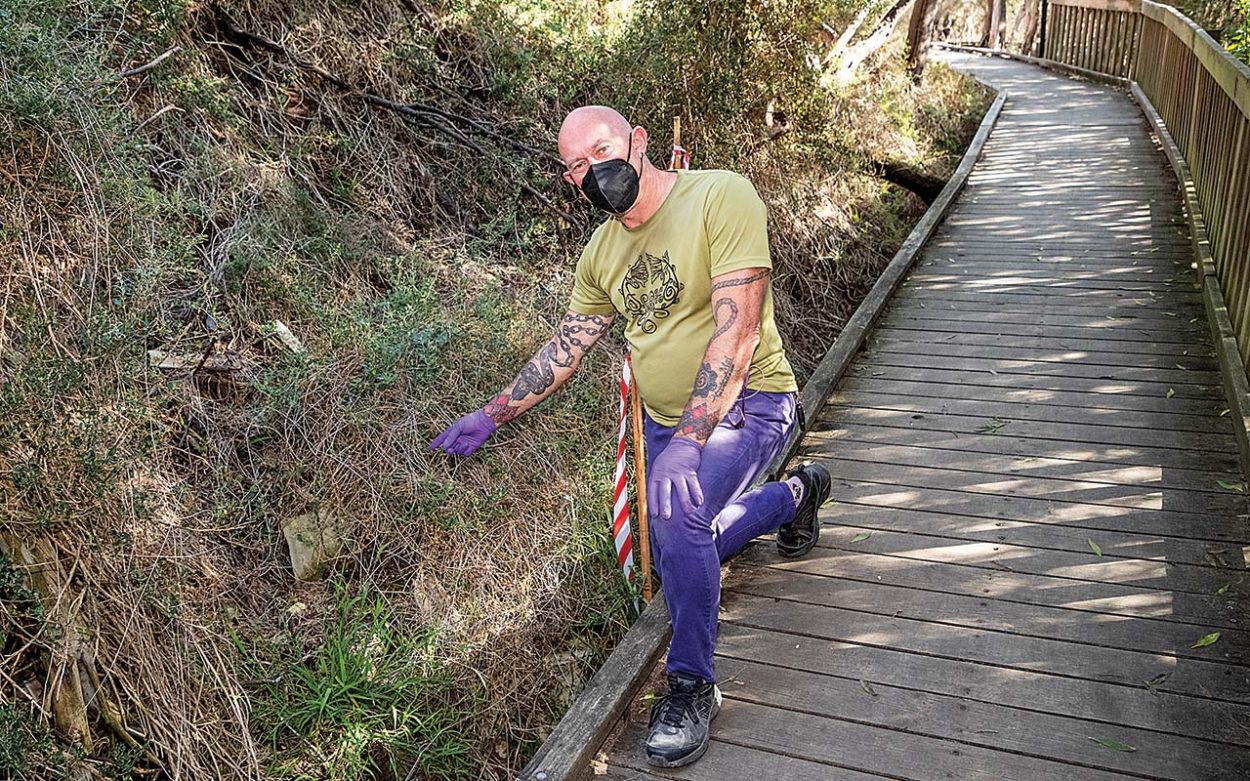MORNINGTON Peninsula Shire will clean up erosion it caused after burying a pile of old asbestos found at the Balcombe Creek Estuary in Mt Martha – two months after it was first reported and taped off. The material, which was left from the former Balcombe Army Camp decommissioned in the 1980s, was discovered among bush scrub on the side of the boardwalk by a resident on April 8.
The site was initially cordoned off with tape, but the public still had access to the pathway while the asbestos was exposed for weeks (“Asbestos found at Balcombe Creek Estuary,” The News 20/05/25). Its location is just a few feet from the walking track, a section which runs parallel to Uralla Rd, between Nepean Hwy and Seppelt Ave. Initially the shire believed the asbestos had been illegally dumped but later confirmed it was a “legacy issue” from the former army camp, which was used during WWII as a training ground.
The resident who found the material was Steve Jones, a professional firefighter and plumber with expertise in asbestos safety. His view was that it was old roofing that was in a non-friable condition where fibres are less likely to become airborne and are not considered a serious public risk. But he said it was a health hazard nonetheless and should have been dealt with immediately.
Mayor Cr Anthony Marsh, in a statement, said the shire undertook an investigation to confirm the asbestos was not illegally dumped. He added that while the material was buried at the site between 16-18 June, recent erosion had exposed it. “Our asbestos team sought specialist advice and safely removed as much of the exposed material as possible,” he said. “It was not safe to remove the remaining asbestos, so it was reburied, and plans are underway to stabilise the area to ensure no further erosion. “All work was done strictly in accordance with WorkSafe and EPA (Environment Protection Authority) guidelines and the surrounding community was notified of the work beforehand.”
However, Jones criticised the shire and the EPA for a “dismal performance” of handling the matter as the site remained exposed for two months, and said “tried to give me the fob off”. “In fairness, [the council] did have a plan, but everything takes so long that by the time they acted, I said ‘you’re missing the point, the asbestos needs to be dealt with immediately’,” he said.
Jones said when he told the EPA and shire about his job, “they went into HR protection mode straight away”. According to Jones, the EPA “never even sent anyone out to look at it”. “A government enquiry needs to go into this because clearly the EPA and the council don’t have any regulations in place or any understanding,” he said, noting the shire needed to implement a standard plan for dealing with asbestos finds. He added the erosion problem could have been completely avoided had they listened to his advice.
Tess Dickie, partner at Gordon Legal, specialising in asbestos, silica, and other dust and occupational disease litigation, said while she had limited knowledge about the issue, she believed the council’s response in dealing with the asbestos at the estuary appeared to be “suboptimal”.
“I would have thought if asbestos has been identified in a local public space that the council would be responding in a timely manner and taking a proactive approach in making sure that the public is notified of the risk and that they are appropriately responding to the risk,” Dickie, also a peninsula resident, said.
“I’m not an expert asbestos removalist, and I’m not fully across what their actual response was behind the scenes but from what I’ve seen in the pictures [from The News], it seems sub-optimal. “I think we’re lucky to have someone like Steve who has some enhanced knowledge about asbestos and recognising it in a public space. Your average resident may not recognise that as a risk and I think there’s an opportunity here for the public to be educated.”
Dickie said her advice for anyone who believed they may have been exposed to asbestos, is to record their exposure through asbestos registers such as that maintained at Gordon Legal or the National Asbestos Exposure Register. “Residents have a right to be concerned, but that said, they should not be panicked or alarmed, they should take sensible steps to protect their own safety.”
The EPA was contacted for comment about its investigation but instead encouraged members of the public to report pollution by calling its 24-hour hotline on 1300 372 842 or epa.vic.gov.au/report-pollution/reporting-pollution. “EPA receives more than 25,000 pollution reports from community and businesses each year. They are an important source of information when it comes to tackling pollution and illegal waste disposal,” it said. “Not only can we respond quickly to serious local issues and emergencies, but they also help us spot the bigger, emerging issues across the state.”
First published in the Mornington News – 8 July 2025



